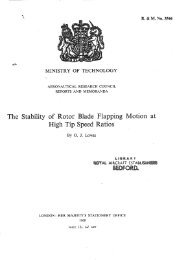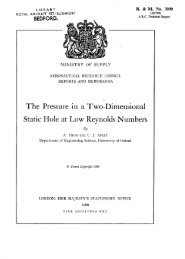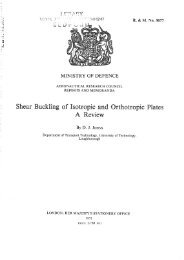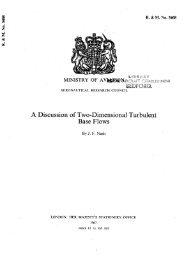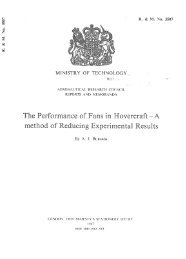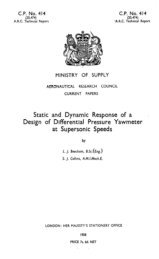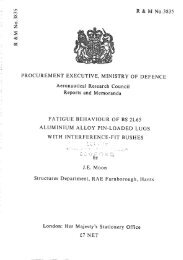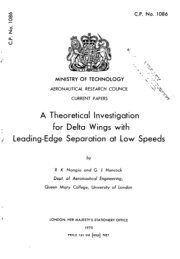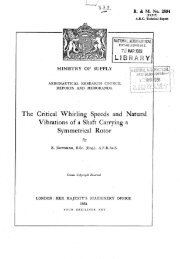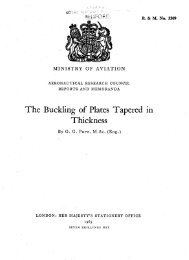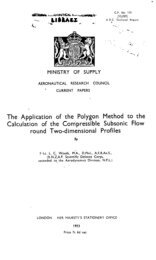The Influence of Surface Waves on the Stability of a ... - aerade
The Influence of Surface Waves on the Stability of a ... - aerade
The Influence of Surface Waves on the Stability of a ... - aerade
Create successful ePaper yourself
Turn your PDF publications into a flip-book with our unique Google optimized e-Paper software.
<strong>the</strong> equati<strong>on</strong>s are<br />
z+ (H+ 2) (8)<br />
With boundary c<strong>on</strong>dltl<strong>on</strong>s u = & = 0, v = -1, at y = 0, ws.ves <strong>on</strong><br />
<strong>the</strong> surface vslll produce a fluotuatl<strong>on</strong> 1X-I <strong>the</strong> velocity at <strong>the</strong> edge <str<strong>on</strong>g>of</str<strong>on</strong>g><br />
<strong>the</strong> boundary layer so that<br />
u, = I + +p = I + A, , say<br />
(We work throughout with complex quantities, <str<strong>on</strong>g>of</str<strong>on</strong>g> which <strong>on</strong>ly <strong>the</strong> real<br />
parts are relevant).<br />
h<br />
where a0 18 <str<strong>on</strong>g>of</str<strong>on</strong>g> <strong>the</strong> order <str<strong>on</strong>g>of</str<strong>on</strong>g> - .<br />
L<br />
pr<str<strong>on</strong>g>of</str<strong>on</strong>g>lle is <strong>the</strong>n<br />
A reas<strong>on</strong>able form for <strong>the</strong> velocity<br />
!J = 1 - ,-y + a0 elx - e-’ (a0 + a,Y t a2 $ + . ..) elx<br />
=1-e<br />
-y+ & - .-y (A, + AIY + A2 z+ Y2 . ..). (11)<br />
where Y = ay and c 1s some suitably cbsen c<strong>on</strong>stant. A, = anelx and<br />
dA<br />
-$ aAn. Squares and products <str<strong>on</strong>g>of</str<strong>on</strong>g> <strong>the</strong> An 's wlllbe assumed negligible.<br />
This form may be made to satisfy any number <str<strong>on</strong>g>of</str<strong>on</strong>g> boundary c<strong>on</strong>dltl<strong>on</strong>s at<br />
y = 0,b.e. at Y = 0), obtained by differentzating <strong>the</strong> equati<strong>on</strong> <str<strong>on</strong>g>of</str<strong>on</strong>g> moti<strong>on</strong>,<br />
and it automatically satlsfles <strong>the</strong> boundary layer equati<strong>on</strong>s at <strong>the</strong> outer<br />
edge. Thus by finding all <strong>the</strong> coefflclents <str<strong>on</strong>g>of</str<strong>on</strong>g> <strong>the</strong> infinite series, an<br />
exact soluti<strong>on</strong> would be given,<br />
set from 0 to=.<br />
slnoe <strong>the</strong> functi<strong>on</strong>s -e<br />
yn<br />
n!<br />
-Y<br />
form a complete<br />
F'racticalvalues <str<strong>on</strong>g>of</str<strong>on</strong>g> h maybe emall compared with 1, and with <strong>the</strong><br />
obvious choice <str<strong>on</strong>g>of</str<strong>on</strong>g> c = 1, It 1s found that <strong>the</strong> quantltres<br />
x43 so that a very large nwlber <str<strong>on</strong>g>of</str<strong>on</strong>g> boundary c<strong>on</strong>diti<strong>on</strong>s<br />
-increase an<br />
as<br />
a0<br />
must be used<br />
to se;ure c<strong>on</strong>vergence <str<strong>on</strong>g>of</str<strong>on</strong>g> <strong>the</strong> series mbrackets. Apart from <strong>the</strong> numerical<br />
difficulties thus raised, bourdary c<strong>on</strong>diti<strong>on</strong>s obtained by repeated<br />
differentlatl<strong>on</strong> with respect to y become inoreaslngly inaccurate because<br />
<str<strong>on</strong>g>of</str<strong>on</strong>g> <strong>the</strong> m&rent approximati<strong>on</strong> in <strong>the</strong> boundary layer equata<strong>on</strong>. It 19,<br />
<strong>the</strong>refore, desirable to use as few terms as possible, and thus may best<br />
- IO -<br />
(7)



